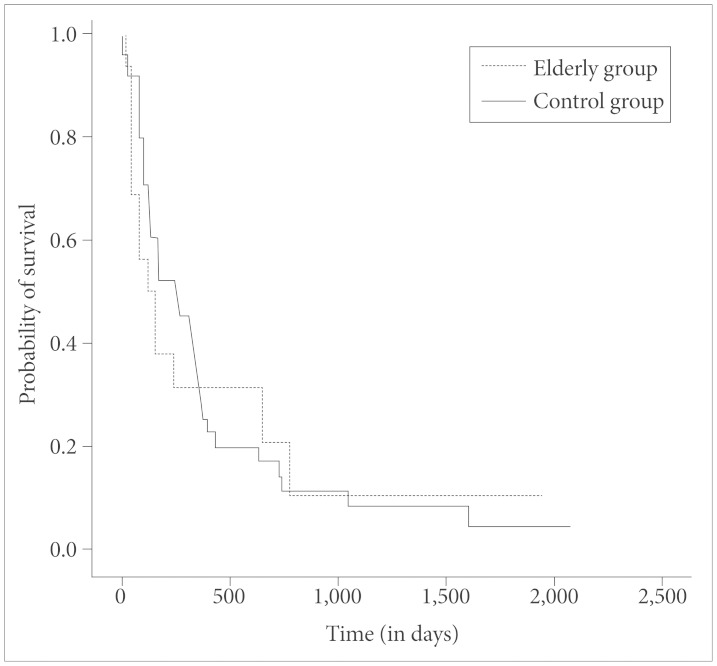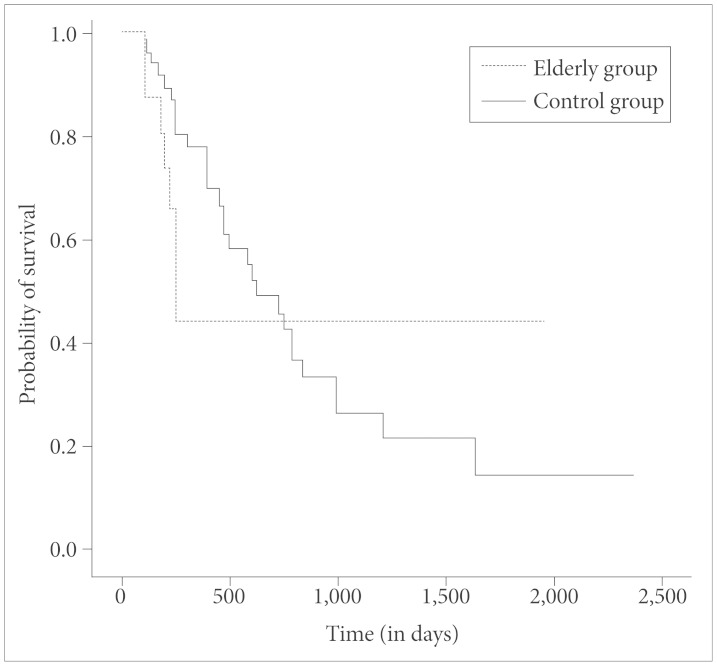Brain Tumor Res Treat.
2014 Oct;2(2):69-75. 10.14791/btrt.2014.2.2.69.
The Clinico-Oncologic Outcomes of Elderly Patients with Glioblastoma after Surgical Resection Followed by Concomitant Chemo-Radiotherapy
- Affiliations
-
- 1Department of Neurosurgery, Konkuk University Medical Center, Seoul, Korea. kohyc@kuh.ac.kr
- KMID: 2134274
- DOI: http://doi.org/10.14791/btrt.2014.2.2.69
Abstract
- BACKGROUND
There have been controversies in the treatment of elderly patients with glioblastoma. We introduce the outcome of the treatment of elderly patients with glioblastoma comparing with younger patients.
METHODS
The author's hospital database was used to identify patients with histologically confirmed glioblastoma after surgery between January 2006 and December 2013. Forty-eight patients (control group) were under age 65 and 16 patients (elderly group) were aged 65 years or over at the time of surgery.
RESULTS
The median age of the elderly group was 71 years and control group was 50 years. Mean number of medical comorbidities was 1.8 in the elderly group vs. 0.5 in the control group. The median progression free survival (PFS) was 5.6 months and the median overall survival (OS) was 19.9 months in all patients. The elderly group had a median PFS of 4.2 months vs. 8 months for the control group (log-rank test, p=0.762). Median OS was 8.2 months in the elderly group vs. 20.9 months in the control group (log-rank test, p=0.457). Major complications occurred in 5 cases (7.8%) for all patients. The ratio of completion of concomitant chemo-radiotherapy (CCRT) was 81.3% and was the same between the two groups. In multivariable analysis, extent of resection (p=0.034) and completion of CCRT (p=0.023) were statistically significant, independent prognostic factors only for PFS in all patients by Cox proportional hazards model. Age was not an independent prognostic factor. As for OS, there was no significant factor.
CONCLUSION
Surgical resection and CCRT were well tolerated in elderly patients with glioblastoma, and maximal safe resection followed by timely CCRT could improve clinic-oncologic outcomes.
MeSH Terms
Figure
Reference
-
1. Holdhoff M, Chamberlain MC. Controversies in the treatment of elderly patients with newly diagnosed glioblastoma. J Natl Compr Canc Netw. 2013; 11:1165–1172. quiz 1173. PMID: 24029128.
Article2. Iwamoto FM, Cooper AR, Reiner AS, Nayak L, Abrey LE. Glioblastoma in the elderly: the Memorial Sloan-Kettering Cancer Center Experience (1997-2007). Cancer. 2009; 115:3758–3766. PMID: 19484785.3. Fisher JL, Schwartzbaum JA, Wrensch M, Wiemels JL. Epidemiology of brain tumors. Neurol Clin. 2007; 25:867–890. viiPMID: 17964019.
Article4. Nguyen LT, Touch S, Nehme-Schuster H, et al. Outcomes in newly diagnosed elderly glioblastoma patients after concomitant temozolomide administration and hypofractionated radiotherapy. Cancers (Basel). 2013; 5:1177–1198. PMID: 24202340.
Article5. Nava F, Tramacere I, Fittipaldo A, et al. Survival effect of first- and secondline treatments for patients with primary glioblastoma: a cohort study from a prospective registry, 1997-2010. Neuro Oncol. 2014; 16:719–727. PMID: 24463354.
Article6. Uzuka T, Asano K, Sasajima T, et al. Treatment outcomes in glioblastoma patients aged 76 years or older: a multicenter retrospective cohort study. J Neurooncol. 2014; 116:299–306. PMID: 24173683.7. Stupp R, Mason WP, van den Bent MJ, et al. Radiotherapy plus concomitant and adjuvant temozolomide for glioblastoma. N Engl J Med. 2005; 352:987–996. PMID: 15758009.
Article8. Piccirilli M, Bistazzoni S, Gagliardi FM, et al. Treatment of glioblastoma multiforme in elderly patients. Clinico-therapeutic remarks in 22 patients older than 80 years. Tumori. 2006; 92:98–103. PMID: 16724687.
Article9. Brandes AA, Compostella A, Blatt V, Tosoni A. Glioblastoma in the elderly: current and future trends. Crit Rev Oncol Hematol. 2006; 60:256–266. PMID: 17027278.
Article10. Keime-Guibert F, Chinot O, Taillandier L, et al. Radiotherapy for glioblastoma in the elderly. N Engl J Med. 2007; 356:1527–1535. PMID: 17429084.
Article11. Werner MH, Phuphanich S, Lyman GH. The increasing incidence of malignant gliomas and primary central nervous system lymphoma in the elderly. Cancer. 1995; 76:1634–1642. PMID: 8635069.
Article12. Laperriere N, Weller M, Stupp R, et al. Optimal management of elderly patients with glioblastoma. Cancer Treat Rev. 2013; 39:350–357. PMID: 22722053.
Article13. Bauchet L, Zouaoui S, Darlix A, et al. Assessment and treatment relevance in elderly glioblastoma patients. Neuro Oncol. 2014; [Epub ahead of print].
Article14. Arvold ND, Reardon DA. Treatment options and outcomes for glioblastoma in the elderly patient. Clin Interv Aging. 2014; 9:357–367. PMID: 24591820.15. Chakrabarti I, Cockburn M, Cozen W, Wang YP, Preston-Martin S. A population-based description of glioblastoma multiforme in Los Angeles County, 1974-1999. Cancer. 2005; 104:2798–2806. PMID: 16288487.
Article16. Saito K, Mukasa A, Narita Y, et al. Toxicity and outcome of radiotherapy with concomitant and adjuvant temozolomide in elderly patients with glioblastoma: a retrospective study. Neurol Med Chir (Tokyo). 2014; 54:272–279. PMID: 24257502.
Article17. Lacroix M, Abi-Said D, Fourney DR, et al. A multivariate analysis of 416 patients with glioblastoma multiforme: prognosis, extent of resection, and survival. J Neurosurg. 2001; 95:190–198. PMID: 11780887.
Article18. Pontes Lde B, Loureiro LV, Koch LO, et al. Patterns of care and outcomes in elderly patients with glioblastoma in Sao Paulo, Brazil: a retrospective study. J Geriatr Oncol. 2013; 4:388–393. PMID: 24472484.19. Kita D, Ciernik IF, Vaccarella S, et al. Age as a predictive factor in glioblastomas: population-based study. Neuroepidemiology. 2009; 33:17–22. PMID: 19325245.
Article20. Barnholtz-Sloan JS, Williams VL, Maldonado JL, et al. Patterns of care and outcomes among elderly individuals with primary malignant astrocytoma. J Neurosurg. 2008; 108:642–648. PMID: 18377240.
Article21. Holdhoff M, Grossman SA. Controversies in the adjuvant therapy of high-grade gliomas. Oncologist. 2011; 16:351–358. PMID: 21339260.
Article22. Laigle-Donadey F, Delattre JY. Glioma in the elderly. Curr Opin Oncol. 2006; 18:644–647. PMID: 16988588.
Article23. Oszvald A, Güresir E, Setzer M, et al. Glioblastoma therapy in the elderly and the importance of the extent of resection regardless of age. J Neurosurg. 2012; 116:357–364. PMID: 21942727.
Article24. Brandes AA, Franceschi E, Tosoni A, et al. Temozolomide concomitant and adjuvant to radiotherapy in elderly patients with glioblastoma: correlation with MGMT promoter methylation status. Cancer. 2009; 115:3512–3518. PMID: 19514084.25. Yin AA, Zhang LH, Cheng JX, et al. Radiotherapy plus concurrent or sequential temozolomide for glioblastoma in the elderly: a meta-analysis. PloS One. 2013; 8:e74242. PMID: 24086323.
Article26. Li J, Wang M, Won M, et al. Validation and simplification of the Radiation Therapy Oncology Group recursive partitioning analysis classification for glioblastoma. Int J Radiat Oncol Biol Phys. 2011; 81:623–630. PMID: 20888136.
Article27. Shamsara J, Shrif S, Afsharnezhad S, et al. Association between MGMT promotoer hypermethylation and p53 mutation in glioblastoma. Cancer Invest. 2009; 27:825–829. PMID: 19544111.
- Full Text Links
- Actions
-
Cited
- CITED
-
- Close
- Share
- Similar articles
-
- Radiotherapy Results of Malignant Astrocytoma and Glioblastoma Multiforme
- Glioblastoma in a Patient with Neurofibromatosis Type 1: A Case Report and Review of the Literature
- Omission of neoadjuvant radiotherapy for clinical T2/N1 and T3N0/1 middle and low rectal cancers with safe circumferential resection margins
- Radiotherapy for Newly Diagnosed Glioblastoma in the Elderly: What Is the Standard?
- A Case of Phantosmia Occurred by Glioblastoma



